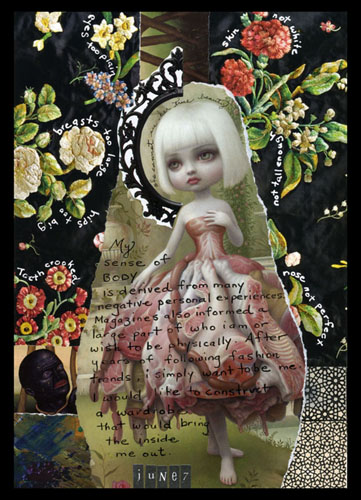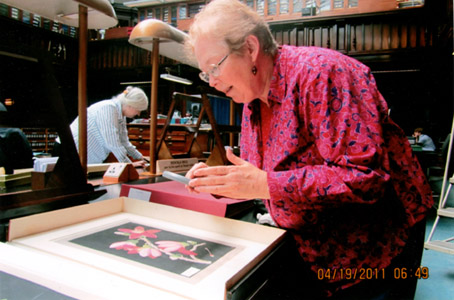
Michelle Casey, "Body Talk", Mixed Media/Collage, June 7 2010 features Mary Delany's embroidery work in the background.
With several projects on the go, I haven’t had much time to read this year. Even still, I’m slowly ploughing through several books. One is Molly Peacock’s: The Paper Garden; the true story of eighteenth century artist Mary Delany, inventor of her very own form of collage (or “paper mosaick”): “Flora Delanica”.
I discovered Mrs. Delany’s exquisite collection of floral needlework and paper mosaicks while constructing some collages for my Pieces of Me II show last year (see “Body Talk”, “The Sound of Silence” and “Losing my Religion”). It’s hard to believe that at age 72, when many of us might have given up the ghost of offering up something new to world, that “Mrs. D”, as she is affectionately known in research circles, pulled it off. I’ve been chasing the elusive dream of becoming a modestly successful artist since I was 27. Twenty years later, I’m realizing there’s still so much to do! So stories like Mrs. Delany’s inspire me and deepen my passion for collage. As a student of art history, I can rattle off the names of several important twentieth-century collage artists who’ve pushed the boundaries of the medium… Pablo Picasso, Georges Braque, Joseph Cornell, Hannah Hoch, Barbara Kruger, etc.. Even Henri Matisse, in his old age, turned to the medium of collage to find new ways of expressing himself; creating his own “garden” of works… but never did I hear of or even imagine little old Mrs. Delany, an amateur artist, working away in her drawing room or study pioneering a new style of collage!
I’m always fascinated by the collage methods of other artists so I was keen to know how Mrs. Delany did it. Her tools of trade were: a filigree-handled scissors, tweezers, a bodkin (for poking holes), a flat bone folder and mortar and pestal (for grounding pigments to make watercolour paint). She re-constructed plant and floral specimens, many of which she may have grown in her own gardens, as well as whose designs she had embroidered onto fine fabrics. With the keen scientific eye of a botanist, she dissected plant specimens in order to understand their likeness so she could reproduce them through collage. Cutting them out from hand-made coloured papers or papers she painted herself, she most probably glued them down with a flour and water paste (or albumen). With my eyesight beginning to fail a bit, I’m amazed at how acute Mrs. Delany’s vision must have been to have pasted down such delicate, minute fragments of paper; equally impressive is her level of dexterity in cutting and laying out these pieces.
Molly Peacock observes that rather than being exact replicas of plants, Mrs. Delany’s floral collages are like memories, and that each work has a personality of its own. If you’d like to see these jewel-like creations to judge for yourself, you can visit the Study Room of the British Museum, as my good friend historian/artist Olive Jones (see photo) did this spring – now she has Flora Delanica mania! If you’re short on funds or time like me, you can admire them on the British Museum’s website. I’m two chapters into the book and am just loving it. I’m so taken with Peacock’s writing/research style and the way her personal history and passions intertwine with Mrs. D’s. If you like art historical biographies and collage or need further creative inspiration, I highly recommend this book.


Sounds like a great read Michelle. I’ve just requested it from the library. Thanks for the great review.
Hello Wendy! That makes two people I’ve convinced to get the book! Mrs. D is really something special. I’d love to hear your thoughts on the book once you’ve had a chance to read it. Thanks so much for taking the time to comment on my blog. Best, Michelle.